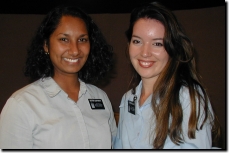
Sister Coopamah and Sister Wallace. | America the Beautiful
Seen on the Railroad Story and Photos by Tim Boxer  HERE’S no better way to see the majesty of unspoiled nature than a rail tour that explores the grandeur of the Northwest. HERE’S no better way to see the majesty of unspoiled nature than a rail tour that explores the grandeur of the Northwest.
Montana Rockies Rail Tours is just the ticket to take you on such a magnificent journey aboard a restored streamliner on original 1880s rail routes. From the several packages available, Nina and I chose the Yellowstone and Grand Tetons tour. This is a 7 day-6 night trip that begins in Salt Lake City, Utah, and ends in Sandpoint, Idaho. There are two categories of service. Discovery Service (with boxed lunch at your seat) is $1,229 double or $1,579 single. Big Sky Service (with lunch elegantly served in the dining car) was $1,479 double or $1,829 single. Everyone had access to the dome car to thoroughly enjoy the vast vistas of this wondrous country. 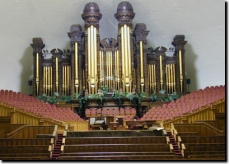
Mormon Tabernacle | We landed in Salt Lake City, and immediately took the requisite tour of the Mormon Temple Square. We were escorted by two young female guides called “sisters.” These young women come from all over the world to spend 18 months learning missionary work and serving as tour guides in this vast Mormon compound. Our guides, both 22, were Sister Wallace from Australia and Sister Coopamah from Mauritius. Aside from two mammoth structures that house the genealogical treasures of the Church of Latter Day Saints, there are three main churches in Temple Square:  | The Tabernacle, domed home of the great Mormon Tabernacle Choir, with the great organ containing 11,623 pipes. Truly an amazing cathedral, erected in 1867.
|  | The Assembly Hall where Sunday services take place. The two main windows are decorated with a huge Star of David. Why a Jewish symbol on a church? “It’s a sign to show that Jesus was Jewish,” Sister Wallace explained.
|  | The Temple, not open to the public. Only upstanding Mormons, with identity cards testifying to their purity of spirit and purpose, are permitted to enter. The building is made up of several rooms where members, attired in simple white clothing, take part in such rituals as baptism, eternal marriage, and religious instruction.
| 
On the boardwalk in Jackson, Wyoming. | After an overnight at the Downtown Marriott, and a hearty breakfast, we took a big comfortable motorcoach for a tour through the city, heading north. Our tour consultant for the duration was Tenar Woodring. A former park ranger and fire fighter, she proved quite knowledgeable about the ways of the west. For lunch we pulled up at the Deer Cliff Inn just over the border in Idaho. The rustic restaurant with knotty pine paneling, bear skin and deer antlers mounted on the walls, is nestled beside a mountain stream, shaded by dense maples and an overhanging rock cliff. 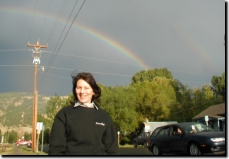
Rainbow over Jackson. | It is said that the Indians would drive the deer over the cliff in preparation for their supper. Roy and Tyra Eichert use more human methods to present a menu of roasted chicken, steaks, trout and honey-buttered scones. Driving back into Wyoming, we passed such small towns as Afton, Star Valley, Thayne. In the tradition of the mountain men and their tall tales, our driver, Preston Shockley, related this apocryphal story: A man robbed a bank and fled on his magical horse named Molly, with a posse close behind. He came to a steep cliff. Without a moment’s hesitation he had his steed sail off the edge. Just before they hit rock bottom, he shouted, “Whoa, Molly!” The horse stopped, and coasted safely to the ground. 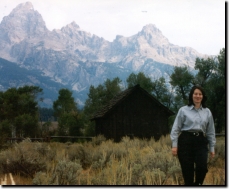
Nina in the sagebrush before the
Grand Teton | Well, the Indians heard about this magical horse and wanted to acquire its potent powers. They caught the robber and tied him to a tree. They slaughtered the horse and proceeded to eat the meat. Nobody would swallow until the chief swallowed first. The chief chewed and chewed. Finally he began to swallow, whereupon all the Indians began to swallow. The robber shouted “Whoa, Molly!” and all the Indians choked to death. Tenar told us how Harrison Ford became a local hero last year. He came to the rescue of two female mountain climbers, one of whom fell ill from heat and dehydration. Harrison flew the stricken woman in his helicopter to a hospital. 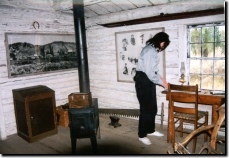
Nina searching for the TV in
Bill Menor’s 1894 cabin. | On our way to Jackson, we saw people in a red raft going down the swirling Snake River. It had rained, so “the world’s longest running shootout on Main Street,” a daily tourist attraction, was cancelled. Of course, we were disappointed, but nature compensated. There above us was an awesome rainbow; actually, two of them. The old west is alive and well in Jackson is what a western town should look like: boardwalks lined with all kinds of shops catering to the tourist trade, saloons, cowboy and Indian souvenir shops, a drugstore with an old-fashioned soda counter. We bumped into James Carville and his family at an Italian restaurant. 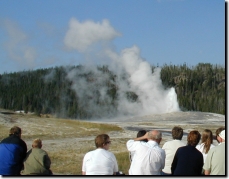
Old Faithful performs again | After overnighting at the 49er Inn, Tenar was waiting for us on the bus with a fresh supply of snacks and drinks. “A woman’s place is in control!” she declared. In short order we found ourselves in Grand Teton National Park. Formed three million years ago, the Tetons are the youngest mountains on the continent, still active and moving. French trappers of the Hudson Bay Company named them the Tetons, meaning “breasts.” Obviously they had a keen eye for breathtaking beauty. Fortunately for us, an early homesteader, Bill Menor, left his 1894 cabin intact. So we were able to see how the early settlers lived. Nina couldn’t understand how they could survive without air conditioner, fridge, washer/dryer and…television! 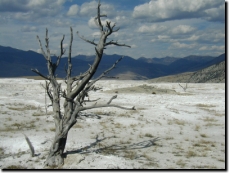
Hot stuff at Mammoth Hot Springs. | Driving through Rockefeller Parkway, a 24,000-acre parcel of land, it was sad to see dead trees standing, denuded of leaves and branches. We witnessed the devastation of thousands of acres due to fire last year. Rockefeller Parkway was named for conservationist John D. Rockefeller. It connects Grand Teton and Yellowstone National Parks. Yellowstone is larger than Delaware and Rhode Island combined, but less than two percent is developed, which leaves plenty of room to roam for bison, antelope, black bear, grizzlies, deer, elk and wolves. After entering through the south gate of the park, we encountered our first bison. Our bus stopped, as did other tourist cars, to let this magnificent beast stroll past on the highway. 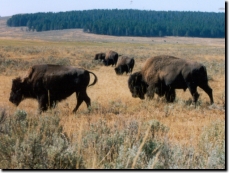
Bison grazing in Hayden Valley. | Now we were standing in one of the world’s largest active volcanoes. Yellowstone is the largest hydrothermal area on earth. We checked into Old Faithful Inn and spent two wonderful days exploring the hot springs, geysers, mudpots and fumaroles. The big attraction, of course, is Old Faithful, visible from the hotel. The world famous geyser erupts every 45-127 minutes. We sat on benches, along with many other visitors, to gaze at one of nature’s most exciting wonders. The steam gently billows from the cone, jets of spray spurt upward, then it blows. Suddenly the boiling hot steam shoots 106-184 feet in the air. We all applaud nature’s performance. We came back an hour later for an encore. We made a pit stop at West Thumb Geyser Basin, on the western shores of Yellowstone Lake, where we spotted a bison foraging among the trees in the parking lot. 
Elk on the lawn. | A massive explosion formed this area some 630,000 years ago. It is believed the interval for a massive eruption of this magnitude occurs about 630,000 years. So we might be in for another one any minute! Among the many attractions we saw at Yellowstone National Park were the Lake Hotel, the oldest hotel in the park; the Grand Canyon of Yellowstone River, 20 miles of cascading water and colorful canyons; Canyon Village with its post office, restaurant, gift shop and bison exhibit; Hayden Valley, where we stopped the bus to stare in awe at a herd of bison grazing on the side of the road; and Mammoth Hot Springs where we walked on a trail to see colorful limestone terraces formed millions of years ago. Finally we emerged from the park into Gardiner, Montana, which straddles Yellowstone River. Elks cross the main street of Gardiner at will. Several people got out of their cars to join us as we watched a dozen elk and their young sprawled on the front lawn of a hotel. They didn’t have antlers, so they were female elk. After spending the night at Comfort Inn, we boarded the motor coach for the last time and drove 53 miles north to Livingston. The town was founded by the Northern Pacific Railroad for its workers. At last we will link up with the Montana Daylight. 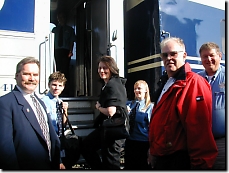
All aboard the Montana Daylight
under the direction of
Mike Phillips (left). | We wait for the train at the Livingston Depot, built in 1902 and renovated in 1987 as a museum to tell the story of railroading in the Pacific Northwest. As winters are pretty cold, the museum is closed from October to May. Besides a variety of artifacts depicting railroad life, the museum also has exhibits from various movies that were shot in the area. They include a 1920s Model T Ford used in A River Runs Through It which Robert Redford produced and Brad Pitt starred. Peter Fonda lives nearby with wife Becky, so the museum has items from Easy Rider (1969), which Fonda produced, directed and starred. Tenar says that it’s become chic for celebrities to own ranches in the state. Ted Turner, the biggest landowner in the U.S., has seven ranches, including a buffalo ranch. “But we don’t mind,” Tenar says. “He doesn’t do anything with the land. He’s a great conservationist.” 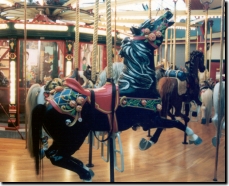
Carousel at Missoula. | Expectations are high as we board the Montana Daylight, a restored 1950s era streamliner train which promises to transport us back to the Golden Age of Rail. We were quite thrilled. Our first day on the rail takes us through the lush green meadows of the Gallatin Valley and the Continental Divide. Mike Phillips, vice president of passenger operations for Montana Rockies Rail Tours, is accompanying us and proves to be a font of knowledge. It was a delight listening to additional commentary from Jan and Bill Taylor who regaled us with funny stories and historical anecdotes. We always sat in the domed car for a great view of the tunnels, trestles, and the last standing wooden water tank in Montana. We even passed a town called Manhattan! We reach Missoula, populated by 55,000 in a valley surrounded by mountains. It boasts one of the first hand-carved carousels built in the country since the Great Depression. This is a quaint town, quiet, with decent restaurants and stores. After a restful night at the Holiday Inn Parkside, we board for a second day of rail travel. We are in the dining car as we pass through the Flathead Indian Reservation, home to three tribes. 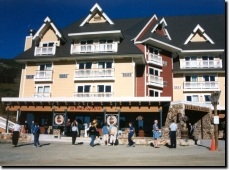
Schweitzer Mountain resort. | Sandpoint, Idaho, is our final destination. We take a motorcoach up to Schweitzer Mountain Resort, a beautiful ski haven. Next morning the motorcoach took us to Spokane Airport for our flight back to New York. You don’t have to wait till summer to enjoy the Northwest. Montana Rockies Rail Tours has a fall schedule that offers several two-day excursions. For diehard football fans there’s a Nov. 16-17 trip along the Missouri River from Missoula to Bozeman for The Battle in Bozeman. At $349 per person, the package includes two days aboard the exciting football train, overnight accommodations at a hotel, continental breakfast, and tickets to the big game with brunch thrown in. There’s a one-day Christmas tour on Dec. 9 from Missoula to Paradise. For $129 for adults, $99 for children, you’ll enjoy a snowy rail ride with Santa Claus, who’ll help you get acquainted with Montana’s stunning winter beauty. Call 800 519-7245 or visit www.montanarailtours.com. |